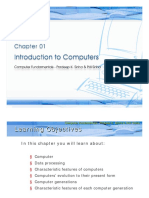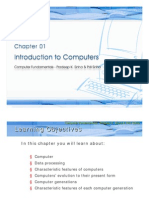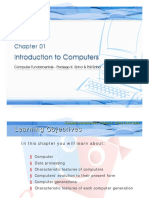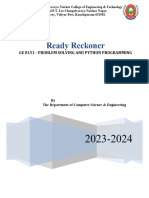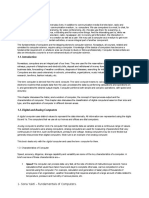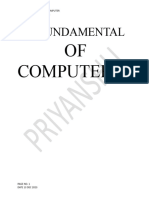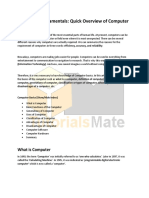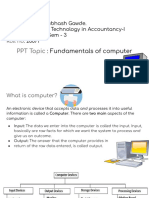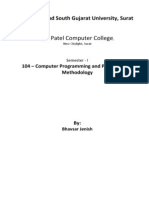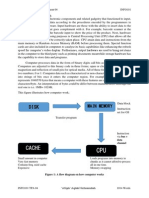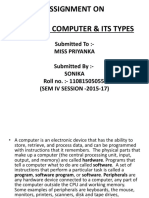Yangon Technological University
1/19
Introduction to Computers
By Dr. Thanda Win
Professor
Department of Computer Engineering and Information Technology
Yangon Technological University
“Computer Fundamentals”, Pradeep K. Sinha and Priti Sinh, 6th Edition, 2011.
Learning Objectives
2/19
1 To know the concept and characteristics of a computer
2 To know the evolutions of computers
3 To know the generations of computers
“Computer Fundamentals”, Pradeep K. Sinha and Priti Sinh, 6th Edition, 2011.
Computer
3/19
• The word computer comes from the word “compute”, which means, “to
calculate”.
• A computer is an electronic device that can perform arithmetic operations at
high speed.
• A computer is also called a data processor because it can store, process,
and retrieve data whenever desired.
“Computer Fundamentals”, Pradeep K. Sinha and Priti Sinh, 6th Edition, 2011.
Data Processing
4/19
The activity of processing data using a computer is called data processing.
Data is a raw material used as input and information is processed data obtained
as output of data processing.billions of cycles per second).
“Computer Fundamentals”, Pradeep K. Sinha and Priti Sinh, 6th Edition, 2011.
Characteristics of Computers
5/19
• Automatic: Given a job, computer can work on it automatically without human
interventions.
• Speed: Computer can perform data processing jobs very fast, measured in micro
seconds (10-6), nanoseconds (10-9) and picoseconds (10-12).
• Accuracy: Accuracy of a computer is consistently high and the degree of its
accuracy depends upon its design. Computer errors caused due to incorrect
input data or unreliable programs are often to as Garbage-In-Garbage-Out
(GIGO).
“Computer Fundamentals”, Pradeep K. Sinha and Priti Sinh, 6th Edition, 2011.
Contd.
6/19
• Diligence: Computer is free from monotony, tiredness, and lack of
concentration. It can continuously work for hours without creating any error
and without grumbling.
• Versatility: Computer is capable of performing almost any task, if the task can
be reduced to a finite series of logical steps.
• Power of Remembering: Computer can store and recall any amount of
information because of its secondary storage capability. It forgets or looses
certain information only when it is asked to do so.
“Computer Fundamentals”, Pradeep K. Sinha and Priti Sinh, 6th Edition, 2011.
Contd.
7/19
• No I.Q.: A computer does only what it is programmed to do. It cannot take its
own decision in this regard.
• No Feelings: Computers are devoid of emotions. Their judgement is based on
the instructions given to them in the form of programs that are written by us.
“Computer Fundamentals”, Pradeep K. Sinha and Priti Sinh, 6th Edition, 2011.
Evolution of Computer
8/19
• Blaise Pascal invented the first mechanical adding machine in 1642.
• Baron Gottfried Wilhelm von Leibniz invented the first calculator for multiplication in
1671.
• Keyboard machines originated in the United States around 1880.
• Around 1880, Herman Hollerith came up with the concept of punched cards that
were extensively used as input media until late 1970.
“Computer Fundamentals”, Pradeep K. Sinha and Priti Sinh, 6th Edition, 2011.
Evolution of Computer
9/19
• Charles Babbage is considered to be the father of modern digital
computers.
Designed “Difference Engine” in 1822.
Designed a fully automatic analytical engine in 1842 for performing
basic arithmetic functions.
Established a number of principles that are fundamental to the design of
any digital computer.
“Computer Fundamentals”, Pradeep K. Sinha and Priti Sinh, 6th Edition, 2011.
Some Well Known Early Computers
10/19
• The Mark I Computer (1937-1944)
• The Atanasoff-Berry Computer (1939-42)
• The Electronic Numerical Integrator And Computer (ENIAC) (1943-46)
• The EDVAC (Electronic Discrete Variable Automatic Computer) EDVAC (1946-52)
• The Electronic Delay Delay Storage Automatic Calculator (EDSAC) (1947-49)
• Manchester Mark I (1948)
• The Universal Automatic Computer I (UNIVAC I) (1951)
“Computer Fundamentals”, Pradeep K. Sinha and Priti Sinh, 6th Edition, 2011.
Contd.
11/19
Atanasoff-Berry Computer
Mark I Computer EDVAC Computer
Manchester Mark I UNIVAC I
“Computer Fundamentals”, Pradeep K. Sinha and Priti Sinh, 6th Edition, 2011.
Computer Generations
12/19
• “Generation” in computer talk is a step in technology. It provides a framework
for the growth of computer industry.
• Originally it was used to distinguish between various hardware technologies,
but now it has been extended to include both hardware and software.
• Till today, there are five computer generations.
“Computer Fundamentals”, Pradeep K. Sinha and Priti Sinh, 6th Edition, 2011.
Contd.
13/19
“Computer Fundamentals”, Pradeep K. Sinha and Priti Sinh, 6th Edition, 2011.
Contd.
14/19
“Computer Fundamentals”, Pradeep K. Sinha and Priti Sinh, 6th Edition, 2011.
Contd.
15/19
“Computer Fundamentals”, Pradeep K. Sinha and Priti Sinh, 6th Edition, 2011.
Contd.
16/19
“Computer Fundamentals”, Pradeep K. Sinha and Priti Sinh, 6th Edition, 2011.
Electronic Device used in Computers of Different Generations
17/19
“Computer Fundamentals”, Pradeep K. Sinha and Priti Sinh, 6th Edition, 2011.
Next Lecture
18/19
Motherboard
The central processing unit ( CPU )
Memory
I/O ports
Hard Disk
“Computer Fundamentals”, Pradeep K. Sinha and Priti Sinh, 6th Edition, 2011.
References
19/19
• Pradeep K. Sinha and Priti Sinh, 6th Edition, 2011.
• https://history-computer.com/the-history-of-harvard-mark-1/
• https://en.wikipedia.org/wiki/UNIVAC_I
• https://en.wikipedia.org/wiki/Punched_card
• https://history-computer.com/the-history-of-harvard-mark-1/
“Computer Fundamentals”, Pradeep K. Sinha and Priti Sinh, 6th Edition, 2011.

